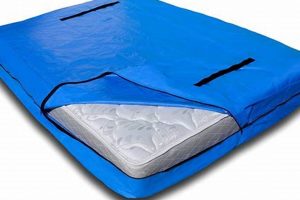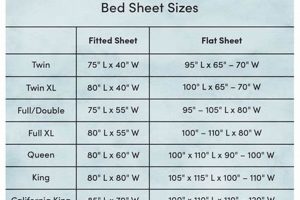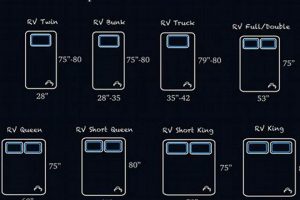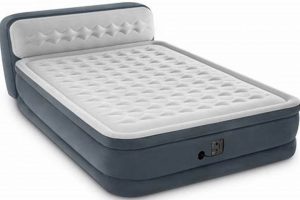The dimensions of a recreational vehicle queen sleeping platform differ from those of a standard residential queen. Typically, it is narrower and shorter, designed to maximize space within the confines of a camper or motorhome. For example, while a standard queen measures 60 inches wide by 80 inches long, an RV variant often measures closer to 60 inches by 75 inches, although variations exist based on the specific RV model and manufacturer.
Optimizing interior living space is a primary consideration in RV design. A more compact sleeping arrangement enables better maneuverability within the vehicle, facilitating access to other amenities and storage areas. Historically, RV manufacturers have prioritized functionality and spatial efficiency, leading to the development of scaled-down furniture and appliances, including mattresses. This design philosophy allows for a more comfortable and practical travel experience.
Understanding these dimensional variances is crucial when selecting replacement bedding or planning interior modifications for a recreational vehicle. The subsequent sections will provide more detailed information on specific measurement considerations, available options, and factors to consider when purchasing a suitable replacement.
Tips Regarding RV Queen Mattress Dimensions
Selecting the correct sleeping surface for a recreational vehicle requires careful consideration of available space and individual comfort preferences. Neglecting these factors can result in an unsuitable and uncomfortable sleeping arrangement.
Tip 1: Measure Accurately. Prior to any purchase, meticulously measure the existing platform. Account for any obstructions or irregularities that may affect the fit. Utilize a measuring tape and record the length, width, and depth of the available space.
Tip 2: Consider Corner Radius. Some RVs feature rounded corners on the sleeping platform. Determine the radius of these curves to ensure the replacement fits flush against the walls. A template may be necessary to accurately reproduce the shape.
Tip 3: Factor in Mattress Thickness. The thickness can impact headroom and access to overhead storage. A thicker mattress offers increased comfort but may compromise available space. A thinner mattress, conversely, improves headroom but may sacrifice support.
Tip 4: Evaluate Support Requirements. Individual sleep preferences dictate the required support level. Side sleepers typically benefit from a softer surface, while back and stomach sleepers often require firmer support. Consider the individual’s weight and sleeping habits when making a selection.
Tip 5: Research Material Options. Memory foam, latex, and innerspring mattresses each offer distinct characteristics. Memory foam conforms to the body, while latex provides responsiveness and durability. Innerspring mattresses offer traditional support and airflow.
Tip 6: Check Return Policies. Verify the retailer’s return policy before making a purchase. A trial period allows for evaluating the mattress’s comfort and suitability. Ensure that returns are permitted if the mattress proves unsatisfactory.
Tip 7: Account for Bedding Fit. Standard queen bedding will often be too large for an RV queen. RV-specific bedding, or custom-sized sheets, may be required for a proper fit, preventing excessive fabric bunching.
Adhering to these guidelines will increase the likelihood of selecting a suitable mattress, optimizing comfort, and ensuring compatibility with the recreational vehicle’s interior dimensions. Failure to consider these aspects can lead to discomfort and necessitate costly replacements.
The next section will delve into specific product options and considerations for upgrading or replacing a recreational vehicle queen sleeping surface.
1. Width
The specification of sixty inches for the width of an RV queen mattress is a foundational constraint in recreational vehicle design. It represents a compromise between sleeping comfort and efficient space utilization within the often-compact confines of RV interiors. Understanding the implications of this fixed width is essential for selecting appropriate bedding and maximizing functionality.
- Space Optimization
The sixty-inch width directly relates to the overall floor plan. This dimension is a key parameter in the arrangement of interior features, such as walkways, storage compartments, and other amenities. RV manufacturers strategically design around this established width to ensure a functional and livable environment.
- Bedding Compatibility
While this dimension is nominally consistent, minor variations can occur between manufacturers. Consequently, individuals should precisely measure the existing platform before purchasing replacement bedding. Standard queen sheets are often too large, requiring RV-specific options or custom alterations to avoid excess fabric and ensure a snug fit. Deviations from the standard sixty inches will necessitate careful consideration during bedding selection to avoid issues with fit and functionality.
- Weight Distribution
The width of the mattress, in conjunction with its material composition, influences weight distribution across the RV’s frame. Uneven weight distribution can impact handling and stability, particularly during transit. A sixty-inch wide mattress, if improperly constructed or positioned, can exacerbate existing weight imbalances within the vehicle.
- Accessibility and Maneuverability
Maintaining a manageable width facilitates movement around the bed. Wider sleeping arrangements would reduce available floor space, impeding access to storage compartments or bathroom facilities. The sixty-inch specification balances sleeping comfort with the pragmatic requirements of interior RV circulation. Designs exceeding this limit would likely compromise the overall usability of the recreational vehicle’s interior.
In summary, the sixty-inch width, while seemingly a single specification, impacts multiple facets of RV design and functionality. Ranging from basic space constraints to dynamic handling while in motion. Careful adherence to this dimension is paramount for creating a comfortable, functional, and safe recreational vehicle environment. Prioritizing awareness of these factors ensures an optimal travel experience.
2. Length
The dimension of seventy-five inches represents a critical component defining the “size of a rv queen mattress”. It directly influences the sleeping comfort and spatial efficiency within a recreational vehicle. This length is a reduction from the standard residential queen mattress, typically 80 inches, and is necessitated by the constrained interior dimensions inherent to RV design. The shorter length allows for greater maneuverability within the vehicle and maximizes available living space. For instance, a design that deviated to the standard 80 inches in length would reduce aisle space, impacting access to adjacent areas such as bathrooms or closets. Therefore, maintaining a length of seventy-five inches is paramount for functional RV layouts.
The selection of seventy-five inches affects material selection and overall mattress support. Manufacturers must consider how to provide adequate support and comfort within the reduced area. This consideration often leads to the utilization of specialized foam or innerspring configurations designed to compensate for the reduced length. Furthermore, the overall comfort is highly influenced with the seventy-five-inch dimension. For example, taller occupants may find the shorter sleeping surface less accommodating, necessitating careful consideration of mattress thickness and support structures to mitigate potential discomfort. These design choices are, therefore, heavily influenced by the need to balance comfort and space savings.
In summary, the seventy-five-inch length of an RV queen mattress represents a deliberate design compromise. It optimizes interior space, impacts comfort, and influences material and construction choices. Awareness of this spatial constraint is essential for both RV manufacturers and owners to ensure functionality. This design directly influences how comfortable and livable the RV space will be.
3. Thickness
The variable thickness of a recreational vehicle queen mattress is a significant consideration intricately linked to its overall size and suitability within the confined space of an RV. This parameter influences comfort, accessibility, and the efficient use of interior volume.
- Headroom Considerations
Mattress thickness directly impacts the available headroom within the sleeping area. A thicker mattress reduces the vertical space between the sleeping surface and the ceiling, potentially causing discomfort for occupants, especially in RV models with lower roof profiles. Conversely, an excessively thin mattress might provide adequate headroom but compromise sleeping comfort and support. RV designers must account for this trade-off to achieve optimal comfort without sacrificing maneuverability within the vehicle. Headroom limitations are a frequent source of complaint if mattress thickness is not properly calibrated.
- Storage Accessibility
Many RVs incorporate under-bed storage compartments. The thickness of the mattress directly affects access to these areas. A thicker mattress requires more effort to lift or maneuver when accessing stored items, potentially rendering these compartments less practical. Thinness also plays a key role. For example, if the mattress is too thin, occupants can easily feel the wooden support beam or the metal structure from the storage area, directly affecting sleep quality. The thickness, therefore, directly impacts the usability of under-bed storage.
- Weight Implications
While width and length are generally standardized for an RV queen, thickness significantly influences the overall weight of the mattress. Thicker mattresses typically contain more material, such as foam or innerspring components, leading to increased weight. This added weight can affect the RV’s fuel efficiency, handling characteristics, and load capacity. Careful consideration of mattress material and thickness is essential to minimize the impact on the vehicle’s performance and safety. For example, an excessively heavy mattress might contribute to uneven weight distribution, affecting stability during transit. Lightness is key to improving gas mileage.
- Comfort and Support
Thickness correlates with comfort and support levels. A thicker mattress may offer enhanced cushioning and pressure relief, especially for side sleepers. Conversely, a thinner mattress may be preferable for individuals who require firmer support or who sleep primarily on their stomach. The relationship between thickness and comfort is subjective and depends on individual preferences and sleeping habits. Understanding this relationship is key to selecting the most suitable mattress for individual needs.
Therefore, the thickness represents a variable factor that considerably impacts the experience. It must be weighed in balance against the need to save space. A balanced approach is required to achieve functional RV dimensions.
4. Corner shape
The corner shape of an RV queen mattress, whether rounded or square, is a significant dimensional characteristic directly impacting its fit and integration within the recreational vehicle’s sleeping area. This feature influences not only the mattress’s spatial efficiency but also the aesthetic coherence of the interior design. The selection of a rounded or square corner shape is often dictated by the existing platform design within the RV. For example, if the sleeping platform features rounded corners, a square-cornered mattress will leave gaps, reducing usable space and potentially creating safety hazards. Conversely, a rounded-corner mattress placed on a square platform may result in an unstable or ill-fitting arrangement.
The choice between rounded and square corners further affects the selection of appropriate bedding. Standard rectangular sheets may not fit optimally on a rounded mattress, leading to bunching or requiring custom tailoring. Conversely, bedding designed for rounded corners may appear ill-fitting and aesthetically displeasing on a square mattress. Practical considerations include ease of installation and removal. Rounded corners may facilitate smoother transitions when maneuvering the mattress within the confined space of an RV, reducing the risk of damage to walls or furniture. Square corners, while potentially maximizing surface area, may present challenges during installation in tight quarters. This influences mattress handling and overall convenience within the RV.
In conclusion, the corner shape of an RV queen mattress is a critical dimensional aspect directly linked to its overall size, fit, and integration within the recreational vehicle. The choice between rounded and square corners involves trade-offs between spatial efficiency, aesthetic harmony, and practical usability. Selecting the appropriate corner shape is essential for ensuring a comfortable, safe, and aesthetically pleasing sleeping arrangement within the limitations imposed by RV design. The integration affects comfort, safety, and spatial efficiency.
5. Weight
The weight of a recreational vehicle queen mattress, intrinsically linked to its material composition, is a pivotal consideration when evaluating its suitability. This factor interacts directly with the dimensional constraints of an RV and has implications for fuel efficiency, load capacity, and handling characteristics.
- Foam Density and Composition
The type and density of foam significantly influence weight. High-density memory foam, known for its conforming properties, typically weighs more than conventional polyurethane foam. Latex foam, derived from natural rubber, presents another option with varying densities. For instance, a high-density memory foam mattress may add considerable weight compared to a similar mattress constructed with lighter, less dense polyurethane. This increased weight influences the overall load on the RV chassis and can impact fuel consumption. The material’s foam and density is the main issue for weight
- Innerspring Coil Gauge and Count
In innerspring mattresses, the gauge (thickness) and number of coils contribute significantly to weight. A higher coil count and thicker gauge provide enhanced support but also increase the mattress’s overall mass. An innerspring mattress with heavy-gauge coils will demonstrably weigh more than a foam mattress, affecting weight distribution and potentially impacting the vehicle’s center of gravity. More coils affect the longevity of use, but also adds to the weight.
- Material Layering and Construction
The layering of different materials, such as foam, fiber, and ticking (outer fabric), further affects the mattress’s weight. A mattress with multiple layers of varying densities will weigh more than a simpler, single-layer construction. Premium RV mattresses often incorporate multiple layers for enhanced comfort and support, inevitably adding to the overall weight. The layers and construction are to allow the weight to distribute throughout the mattress
- Gel Infusions and Additives
Some mattresses incorporate gel infusions, designed to regulate temperature and enhance comfort. These additives, while beneficial for sleep quality, contribute to the mattress’s overall weight. Similarly, fire-retardant chemicals, mandated by safety regulations, add to the total mass. Gel beads and fire-retardant influence the overall weight of the mattress.
The material composition dictates the weight within the dimensional framework of an RV queen mattress. Understanding these weight implications is essential for making informed decisions that balance comfort, support, and the overall operational characteristics of the recreational vehicle. Prioritization of materials and RV weight influences safety and fuel economy.
6. Support core
The support core, whether foam or innerspring, is a primary determinant of comfort, durability, and overall suitability within the dimensional constraints characteristic of a RV queen sleeping platform. The selection of a core material directly influences the mattress’s weight, responsiveness, and ability to provide adequate spinal alignment.
- Foam Core Characteristics
Foam cores, typically constructed from polyurethane, memory foam, or latex, offer varying degrees of conforming support. Memory foam excels at pressure relief by contouring to the body’s shape, while latex provides a more responsive and buoyant feel. The density of the foam affects its durability and supportiveness. Higher-density foams generally offer greater longevity and resistance to compression. In the context of a size-limited RV queen, foam cores can be advantageous due to their lighter weight and ability to be compressed for easier maneuverability during installation or storage. For example, a multi-layered foam core, incorporating both high-density support foam and a plush memory foam comfort layer, balances support and comfort within the restricted dimensions.
- Innerspring Core Characteristics
Innerspring cores utilize a network of metal coils to provide support. Coil gauge (thickness) and coil count (number of coils) influence the firmness and responsiveness of the mattress. Bonnell coils are a traditional innerspring design, while pocketed coils, individually wrapped in fabric, minimize motion transfer. Innerspring mattresses tend to be heavier than foam mattresses, a significant consideration within the weight limitations of an RV. However, they often offer superior airflow and a more traditional feel. As an example, an RV queen innerspring with a high coil count and a tempered steel perimeter wire offers enhanced edge support, maximizing the usable sleeping surface within the size-restricted platform.
- Dimensional Adaptations
Irrespective of the core material, RV queen mattresses require dimensional adaptations to fit the standard RV queen size. Foam cores can be readily cut and shaped to conform to rounded corners or specific platform dimensions. Innerspring cores, however, require more specialized manufacturing techniques to achieve the correct size and shape. For instance, innerspring mattresses may feature reduced coil counts or modified coil configurations to accommodate the shorter length (75 inches) typically found in RV queen platforms. Ensuring accurate dimensions is crucial for preventing gaps between the mattress and the platform, which can compromise support and safety.
- Weight Considerations and Fuel Efficiency
The weight of the support core directly impacts the recreational vehicle’s fuel efficiency and load capacity. Heavier innerspring mattresses contribute more to the overall vehicle weight than lighter foam options. Overloading the RV can compromise handling and increase fuel consumption. As an example, choosing a lightweight foam core can improve fuel economy, especially on long trips, thereby reducing operational costs. Therefore, selecting the most suitable support core requires a careful assessment of weight limitations and operational requirements in the context of RV travel.
In summary, the choice of support core, whether foam or innerspring, must be carefully considered in relation to the RV queen’s dimensional constraints. Foam cores offer advantages in terms of weight and adaptability, while innerspring cores may provide a more traditional feel and enhanced airflow. Irrespective of the core material, accurate dimensional adaptations are essential for ensuring a comfortable and functional sleeping surface within the restricted space of a recreational vehicle. These choices impact not only comfort, but also fuel economy.
7. Bed frame dimensions
The dimensional correspondence between an RV queen mattress and its supporting bed frame represents a critical element in ensuring both comfort and structural integrity within the confined space of a recreational vehicle. Mismatched bed frame dimensions can lead to inadequate support, premature mattress wear, and potentially hazardous conditions within the RV interior. For instance, a bed frame that is too large will allow the mattress to shift during transit, increasing the risk of damage and potentially causing injury. Conversely, a frame that is too small will compress the mattress, leading to uneven wear and reduced comfort over time. The proper alignment between these two dimensional spaces is therefore paramount.
The influence of bed frame dimensions extends beyond basic support. In RVs with integrated storage compartments beneath the bed, the frame’s dimensions directly affect access to these storage areas. A poorly fitted frame can obstruct access, rendering these compartments unusable. Furthermore, the frame’s height influences overall sleeping comfort. If the frame is too high, it may become difficult to climb into bed, particularly for elderly individuals or those with mobility limitations. Conversely, if the frame is too low, it may restrict airflow beneath the mattress, potentially leading to moisture buildup and mold growth. For instance, several RV owners have reported issues with mildew and water damage after improperly adjusting their bed frames.
In summary, the fit of the bed frame to the RV queen mattress is a crucial determinant of comfort, safety, and functionality. Addressing this dimensional relationship is essential for ensuring a secure and comfortable sleeping environment within the limited space of a recreational vehicle. RV owners should carefully measure both the mattress and the bed frame before installation to ensure a precise and secure fit, maximizing both safety and utility. Improper fit can lead to a domino effect of negative consequences, impacting both the mattress and the RV’s infrastructure.
Frequently Asked Questions
The following section addresses common inquiries concerning the dimensions of recreational vehicle queen mattresses. Accurate knowledge of these dimensions is crucial for ensuring a comfortable and functional sleeping arrangement within the limited space of an RV.
Question 1: What are the standard dimensions of an RV queen mattress?
The typical RV queen mattress measures approximately 60 inches in width and 75 inches in length. The thickness can vary considerably depending on the construction and materials used.
Question 2: How does the size of an RV queen mattress differ from a standard residential queen?
A standard residential queen mattress is generally 60 inches wide and 80 inches long. The RV queen, therefore, is shorter in length to accommodate the spatial constraints of recreational vehicles.
Question 3: Are there variations in RV queen mattress sizes?
Yes, slight variations may exist depending on the RV manufacturer and model. It is recommended to measure the specific sleeping platform to ensure an accurate fit.
Question 4: Can standard queen-size bedding be used on an RV queen mattress?
Standard queen-size sheets are generally too large for an RV queen mattress. It may be necessary to purchase RV-specific bedding or have custom-sized sheets made.
Question 5: What factors should be considered when selecting an RV queen mattress?
Key factors include the dimensions of the sleeping platform, desired comfort level, support requirements, mattress weight, and the available headroom within the RV.
Question 6: Where can one purchase an RV queen mattress?
RV queen mattresses are available at RV dealerships, online retailers specializing in RV supplies, and some mattress stores that offer custom sizing options.
In summary, understanding the dimensional specifics of RV queen mattresses is essential for ensuring a comfortable and well-fitted sleeping arrangement within a recreational vehicle. Prioritizing accurate measurements and considering individual needs will facilitate a satisfactory purchase.
The subsequent section will provide a comprehensive comparison of RV queen mattress types and their respective benefits.
Conclusion
The foregoing analysis has elucidated the importance of “size of a rv queen mattress” within the context of recreational vehicle design. Understanding its specific dimensionsparticularly the variance from standard residential measurementsis critical for optimizing space utilization, ensuring proper bedding fit, and maintaining overall comfort. Factors such as width, length, thickness, corner shape, weight, support core, and bed frame dimensions all contribute to the suitability of a given mattress within the constraints of an RV interior.
Consideration of these dimensional parameters is not merely a matter of convenience but a necessity for maximizing the functionality and livability of the recreational vehicle. Further research into mattress materials, construction techniques, and individualized comfort preferences will further enhance the RV experience, ensuring that the limited space is used to its fullest potential. This knowledge empowers informed decision-making, leading to improved comfort and safety on the road.




![Best Hybrid Queen Mattress [Year]: Comfort & Support Organic & Natural Mattress Buyer’s Guide: Non-Toxic Sleep Solutions Best Hybrid Queen Mattress [Year]: Comfort & Support | Organic & Natural Mattress Buyer’s Guide: Non-Toxic Sleep Solutions](https://mattressworldpa.com/wp-content/uploads/2025/07/th-2259-300x200.jpg)


